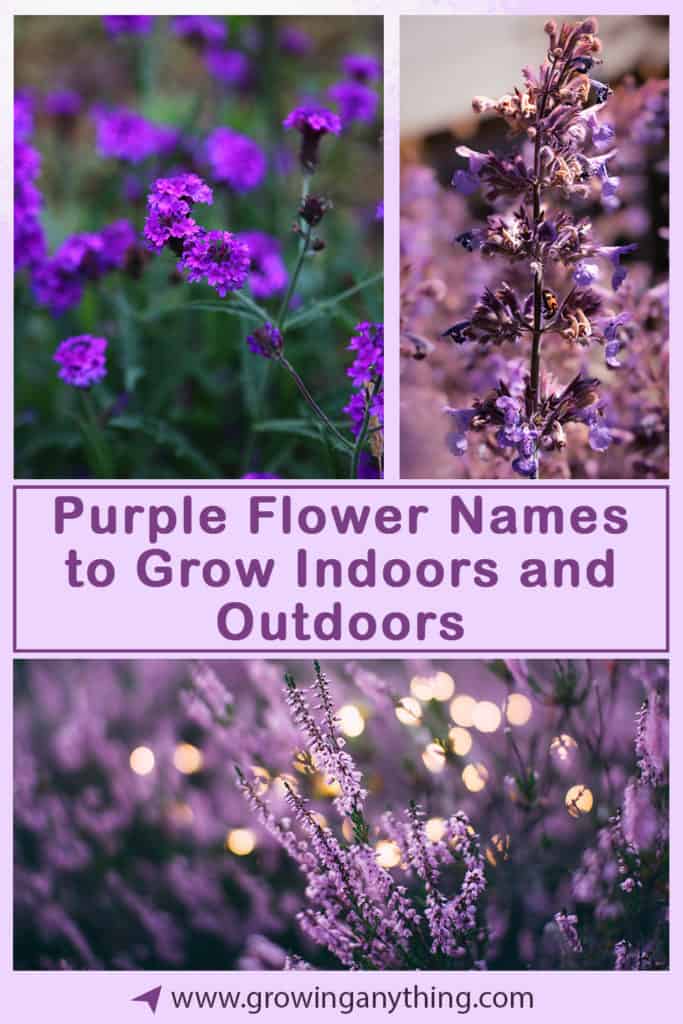63 Purple Flower Names
My purple flower names list contains beautiful flowering plants, shrubs, and trees you can grow in your garden or home. Purple blooms are exotic, lavish, royal, and pair well with all other flowers – bright and pastel! The combination of a purple flower and green foliage is sophisticated and adds a touch of creativity to every garden.
When grown indoors, purple flowers are the only decoration you’ll ever need. Some of these flowering plants need a bit of love and care to produce their stunning blooms, but others are easy to maintain and will come back every year with vivid flowers.
Get ready for the most beautiful purple flowers!
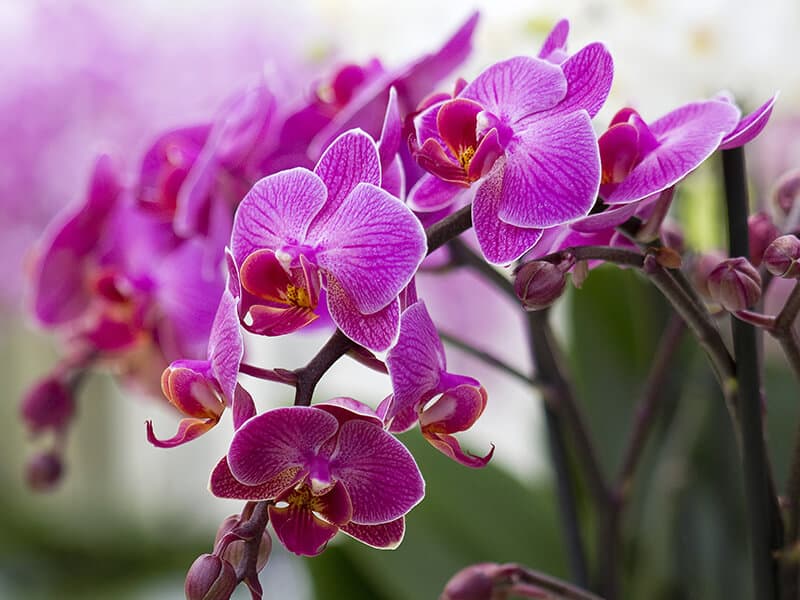
Outdoor Purple Flower Names
If you are looking for inspiration for your garden to add a pop of color, purple flowers are great. Check the list and choose your top picks!
#1 Lavender
Lavandula or simply Lavender is easy to grow in pots and flowering beds. The plant looks charming and is adored for its beautiful scent. It needs full sun location and a lot of water until it establishes!
Find out how to plant Lavender!
#2 Catmint
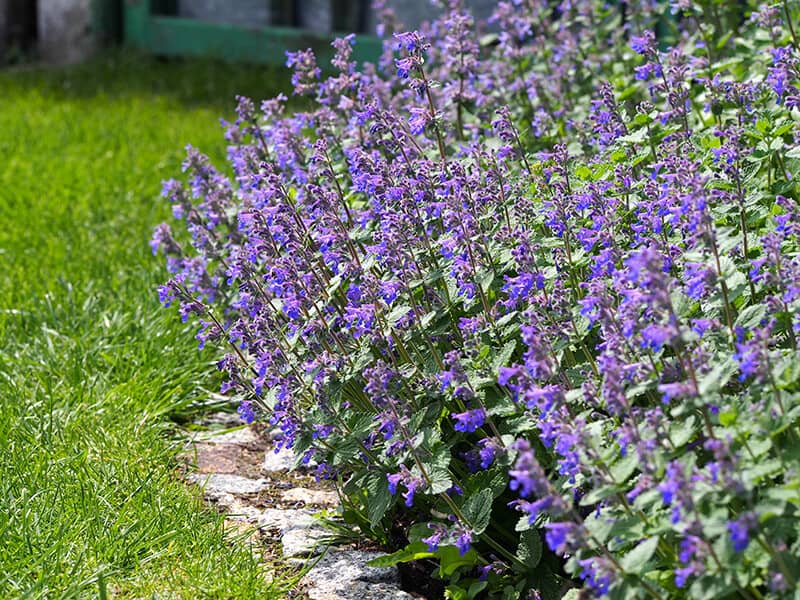
Catmint is aromatic and looks similar to Lavender. There are two varieties – Nepeta mussinii and Nepeta cataria. The latter is called Catnip and has less ornamental value.
Both are grown easily in gardens, especially near vegetables because of their insect-repellent properties.
If you have a cat, find out how Catmint can affect your pet!
#3 Clematis
Clematis viticella is often called Italian leather Clematis. It is well-known for its lush purple flowers that appear at the beginning of the summer and last till the end of the fall. Keep in mind that Clematis is a poisonous plant!
Discover more information on purple Clematis!
#4 Verbena
Verbena bonariensis is a colorful plant that is extremely easy to grow. It is a drought-tolerant plant that will brighten your garden year-round!
The plant has stunning bright purple flowers and a low-growing habit. You can grow it from seeds and cuttings!
Check how simple to grow Verbena is!
#5 Bellflower
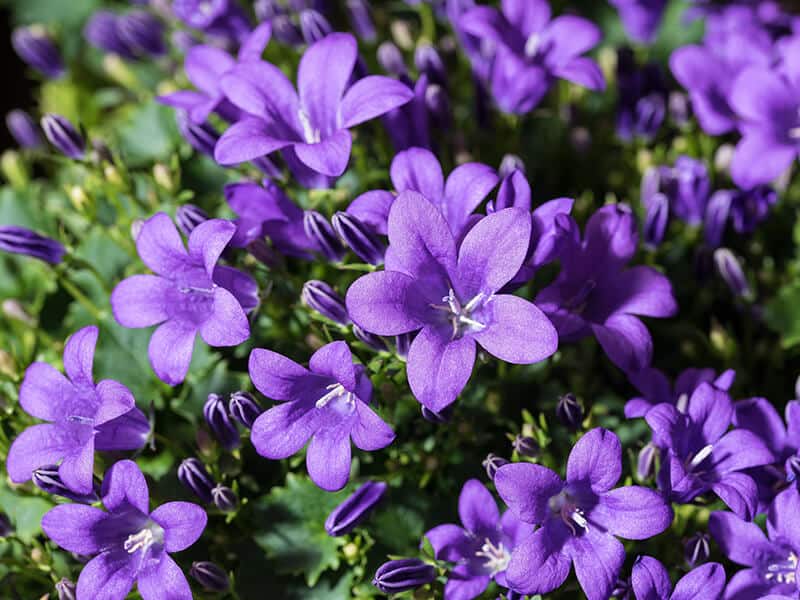
Campanula forms clumps of violet-blue flowers. The flowers are bell-shaped and slightly dropping which gives the plant a fuller appearance.
It is an invasive perennial that can take over your garden, if you don’t keep an eye on the plant. There are several exotic-looking varieties, and most of them are easy to grow.
Read more about Campanula flowers!
#6 Butterfly Bush
Buddleia or Butterfly bush is a fast-growing plant that develops masses of purple flowers! It is an excellent choice if you want to cover a larger surface in the full sun location. Butterfly bush attracts birds, so you plant it around plants prone to pests to keep them under control.
Read more interesting facts about Butterfly bush!
Find out why Butterfly Bush an excellent garden plant is:
#7 Gloxinia
The botanical name of beautiful Gloxinia is Sinningia speciosa. It comes from Brazil and looks similar to African Violets with its large and multi-colored flowers.
The foliage is also stunning with a velvety texture and rich appearance.
Find out what varieties of the popular Gloxinia are there!
#8 Balloon Flower
Balloon flower is a lovely plant with star-shaped blue-purple flowers that appear from balloon-shaped bulbs, hence the name. The botanical name of the plant is Platycodon grandiflorus.
It is an easy grower that blooms summer long!
Here is how to take care of a Balloon Flower!
#9 Sweet Pea
Sweet Pea or Lathyrus odoratus is a vining plant, so it needs support. You can train it to grow on the trellis and create a stunning purple flowers display! Sweet Pea is an annual plant, but it has a long-lasting impact on your garden!
Are Sweet Peas used as cut flowers? Click here to find out!
#10 Dwarf Iris
Dwarf Iris, or scientifically, Iris pumila is a short plant, with single flowers appearing on 5-inch tall stems. The plant thrives in slightly alkaline soil with well-draining properties. It has a bushy-growing habit so it is perfect for filling in the bald spots in the garden.
Find out if Dwarf Iris is poisonous.
#11 Calla Lily
Only a few flowers have such a breathtaking effect like purple Calla Lily or Zantedeschia. The unique-looking flowers appear on tall and slim stems, giving the plant a sophisticated appearance. Calla Lily has flowers of different colors, but the variety Night Cap and Coastal Purple are my favorites!
Discover how to take care of Calla Lily.
What to do with Calla Lily flowers? Watch this video to know:
#12 Salvia
Salvia officinalis or Garden sage is the plant used in the kitchen as an aromatic spice. However, during the bloom season, Salvia develops charming blue-purple leaves.
The plant is also used in aromatherapy and is believed to increase alertness and memory.
Find out more benefits of the Salvia plant!
#13 Hellebore
Purple Hellebores need moist, but not soggy soil and partial shade. Once you plant it, you’ll have to water it frequently. But, as the plant grows it becomes a low-maintenance plant and awards you with rich purple flowers with wide and delicate petals.
Learn more about ideal soil requirements for Hellebore!
#14 Monkshood
Aconitum or Monkshood is a plant commonly used in landscaping, as a background plant. On average, the plant reaches four feet in height and about two feet in width.
Because the natural habitats of the plant are woodlands, and moist meadows, Monkshood should be planted in a similar soil type.
However, ensure well-drainage to prevent rotting.
Here is more information about the Monkshood plant!
#15 Purple Hibiscus
Alyogyne huegelii or Purple Hibiscus is a fast-grower. It doesn’t need a lot of water, and it is generally drought-tolerant. The plant blooms through the entire growing season and sometimes repeats flowers year-round.
Check out more about the Purple Hibiscus plant!
#16 Allium
Allium or Ornamental Onions feature globe-shaped purple blooms that stand out in every garden setting. These plants are perfect for garden borders because of their ornamental value. They also pair well with all other plants and bloom in summer.
Discover more growing tips for Alliums!
#17 Zinnia
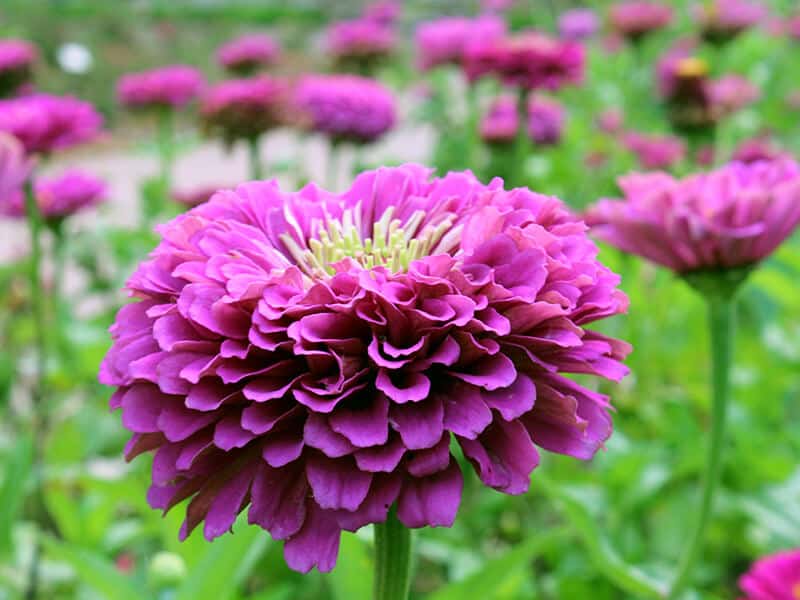
In most USDA hardiness zones, Zinnia is an annual plant. Numerous cultivars develop stunning colorful flowers, and the purple cultivars are sometimes available in bi-color and tri-color varieties.
Zinnias are easy to grow, as long as you plant them in full sun location, ideally in June.
The best tips for getting the most out of your Zinnia. Watch this video below:
#18 Alpine Betony
Stachys monieri Hummelo or Alpine Betony is close relative to the plant Lamb’s ear, but it looks completely different. The plant has velvety leaves and a non-spreading growing habit. The upright purple flowers appear in the summer and last for several weeks.
The plant grows well around other plants!
Check out primary information on this perennial plant!
#19 Aster
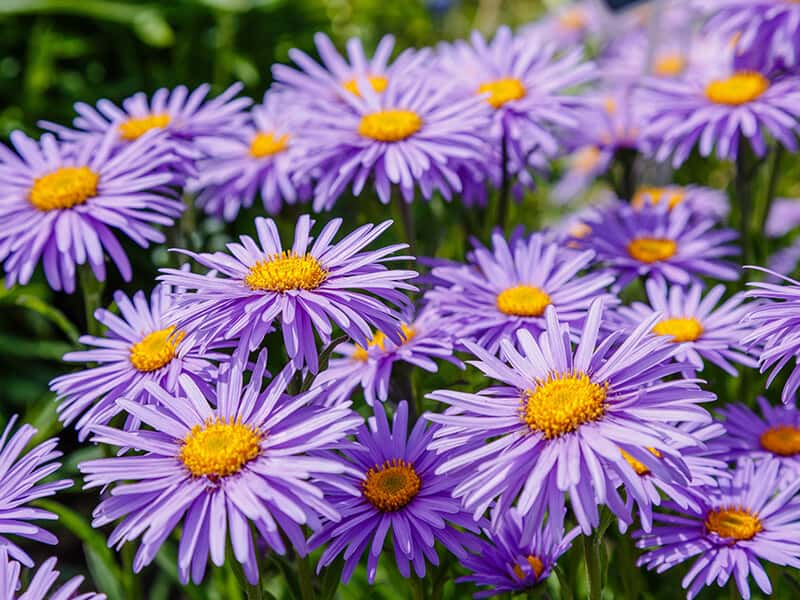
Aster alpinus is native to mountains in Europe and a slow-growing plant. It has beautiful light-purple, daisy-like flowers with bright yellow centers. The solitary flowers develop on tall and slender stems and are very attractive to birds and insects.
Find out more about Aster plants!
#20 Lisianthus
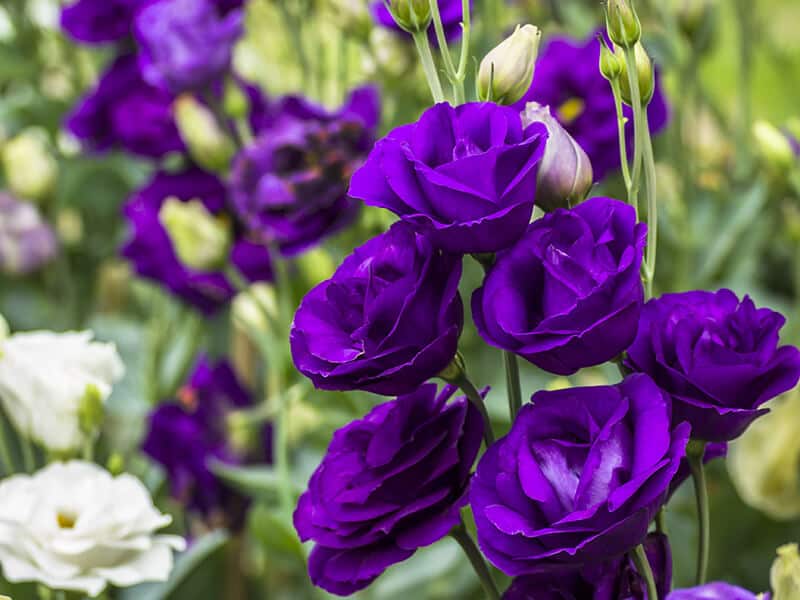
Lisianthus is a perennial plant in warmer USDA zones. The scientific name is Eustoma russellianum, and the plant has a nasty reputation. Most people believe it is hard to grow. However, the variegated flowers in the shades of white and purple are worth the effort!
Be patient with Lisianthus as it needs more time than other similar plants to reach maturity.
Read the full guide on how to grow Lisianthus in your garden.
#21 Hydrangea
Purple Hydrangeas are great for partial shade locations! Their bluish and purple flowers may change color when the pH value of the soil changes. For example, in acidic soil, the flowers get a deeper purple shade. In alkaline soil, you can expect your Hydrangeas to transform pink.
How to grow Hydrangeas in your garden? Click here to find out!
#22 Sea Holly
Eryngium or Sea Holly is a statement plant in every garden with its bluish, purple bracts that produce flowers. The stems are around 30 inches tall in unusual shades of silver and blue. The plant usually spreads around one foot in width and blooms from summer to mid-fall.
Sea Holly prefers sandy soil and full sun exposure!
Discover all attractive Sea Holly varieties!
Find out how to grow Sea Holly in pots:
#23 Morning Glory
With its slender stems, heart-shaped foliage, and bright blooms, Morning Glory is an attractive plant. The plant can grow on the pergola or an arch and create a colorful setting.
Morning Glory is one of the self-seeding plants. So it may overgrow the space you intended for it. Therefore, monitor the plant to keep it in the desired size and shape!
The scientific name of the plant is Ipomoea purpurea.
Find out how to train Morning Glory to grow in the direction you want!
#24 Rhododendron
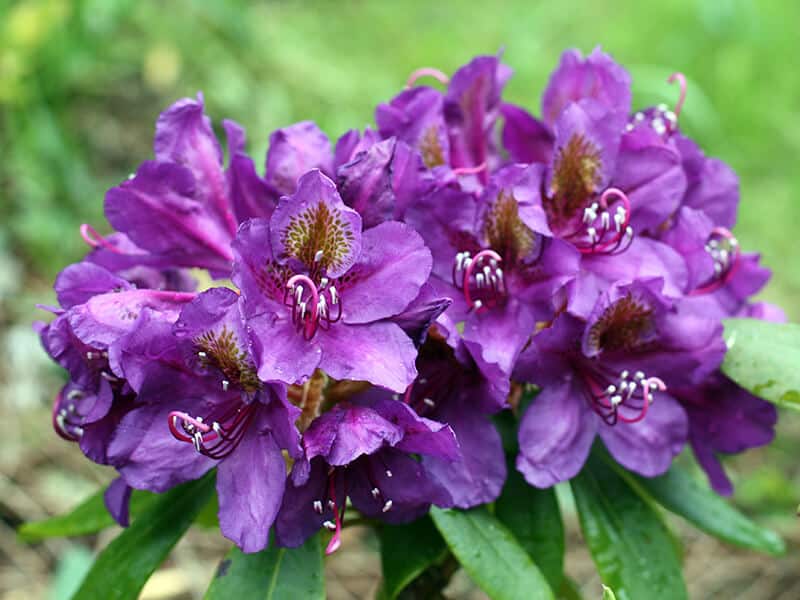
A bushy Rhododendron is a brilliant choice if you have locations in your garden that are shaded. However, the plant needs wind protection to thrive. In fact, the plant only needs minimal care to remain healthy – regular watering, pruning, and dead-heading.
How to use Rhododendron in landscaping? Click here to find out!
#25 Purple Pansy
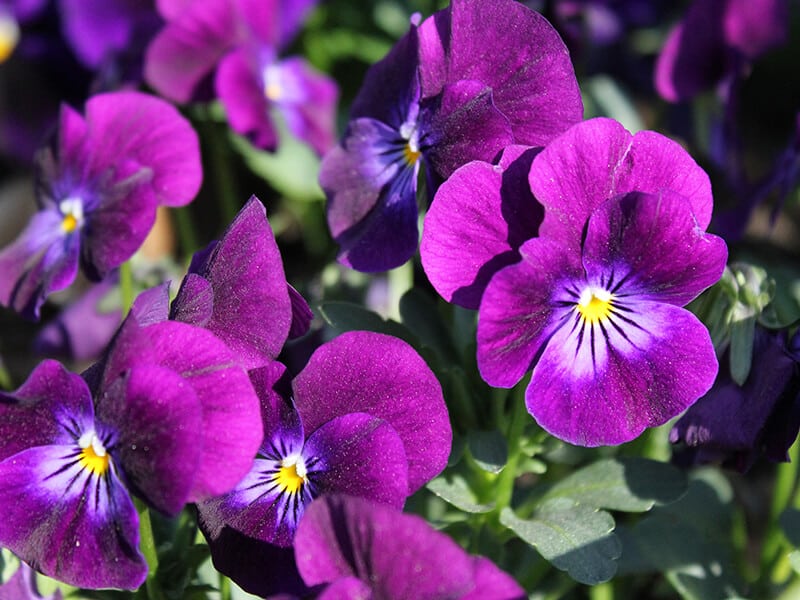
The hybrid variety Viola × wittrockiana or simply Purple Pansy is derived from several species. It has large, multi-colored flowers and is the perfect choice for cool climates.
Purple Pansies grow well in flowering beds and come back year after year if you take good care of them.
Find out how to grow Purple Pansies!
#26 Petunia
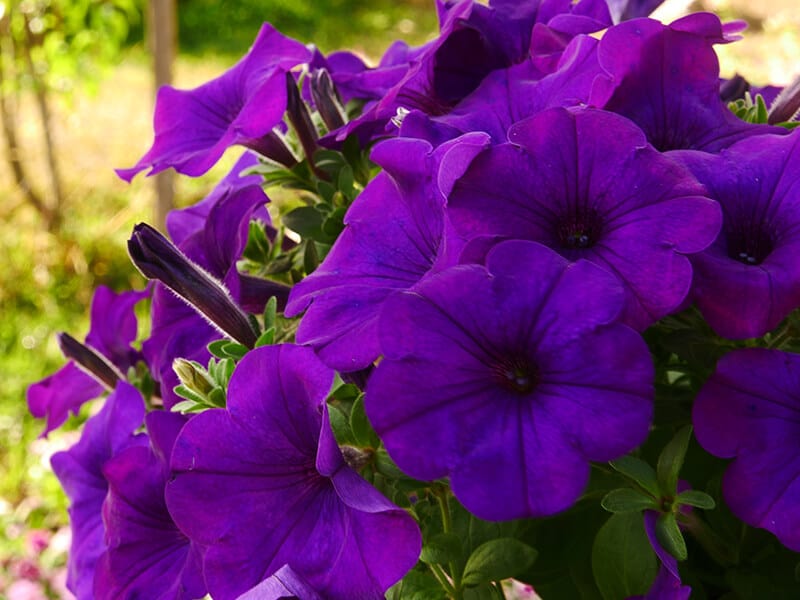
Purple Petunias, especially Surfinia Purple cultivars, are wonderful garden plants. They feature large flowers in deep purple and dark, almost black centers. You can grow them in containers, hanging pots, and in your garden.
The plant is easy to grow and the flowers are weather resistant.
Find out the symbolism behind the Purple Petunia flower!
#27 Scabiosa
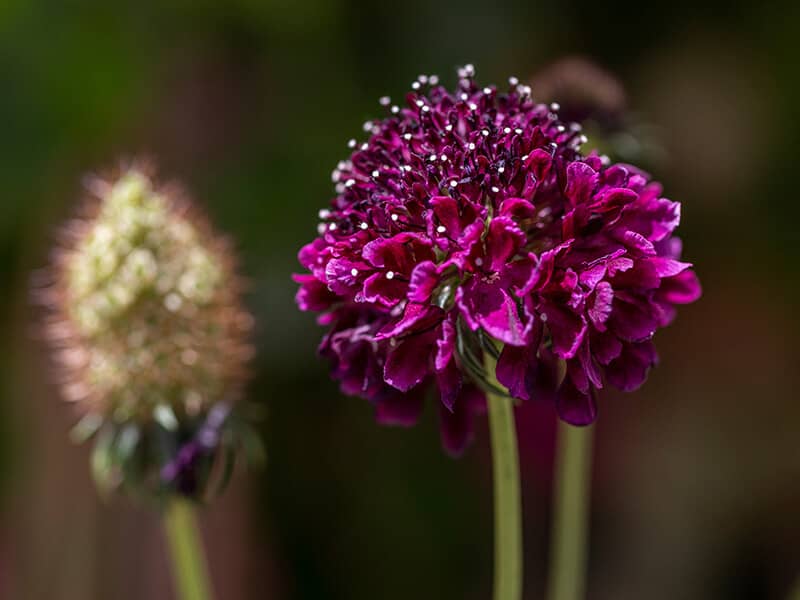
Pincushion flower or Scabiosa is a tiny purple flower coming from Europe. It is a low-maintenance plant, but if you live in a cold climate, I recommend you to start it indoors and then transplant it in the garden soil once the temperature rises.
Did you know that a single stem of the Scabiosa plant may produce from 20 to 50 flowers?
Can you use Scabiosa as a cut flower? Find out now!
#28 Pasque Flower
Pulsatilla or Pasque flower is a tundra plant. It has a low-growing habit and is famous for its eye-healing properties. The Pasque plant has silky hair on the stems, which improves the insulation of the plant and helps the plant to survive cold weather.
Find out more about this lovely plant suitable for colder climates!
#29 Lily of the Nile
Despite the name, Lily of the Nile has nothing to do with the Nile or Africa. The plant grows from a rhizome and has large leaves. Agapanthus is a botanical name of this plant, and the plant needs the care to develop to its fullest potential.
You’ll have to fertilize the plant several times per year to ensure blooming. Propagate the plant to keep it alive.
Find out when and how to propagate Lily of the Nile!
#30 Anemone
Anemone coronaria, shortly Anemone or Poppy, is a bright flowering plant that bursts into color in an early bulb. The plant spreads relatively fast and develops large flowers in different colors.
You can grow Poppies in pots and as ground covers.
Read what it takes to grow Anemone!
#31 Bee Orchid
Ophrys Apifera is commonly known as Bee Orchid. It is an intriguing plant whose flowers resemble the female bee in look and scent.
Bee Orchid is rare in the USA but worth the search! The plant thrives in moist and rich soil.
Learn where to look for your Bee Orchids!
#32 Blue-Eyed Grass
Sisyrinchium or Blue-Eyed Grass belongs to the Iris family and has star-shaped, pastel purple flowers. The plant looks delicate, but it is actually hardy and easy to grow.
It is a small plant, perfect as a ground cover.
Discover more properties of Blue-Eyed Grass!
#33 Carnation
Dianthus Caryophyllus or Carnation is an inexpensive flowering plant, used as a cut flower. The plant is grown for its puffy blooms with a sweet fragrance!
The Carnation plant flowers in the summer and cut flowers stay fresh for a long time!
Discover more about ideal growing conditions for Carnation!
#34 Cattleya Orchids
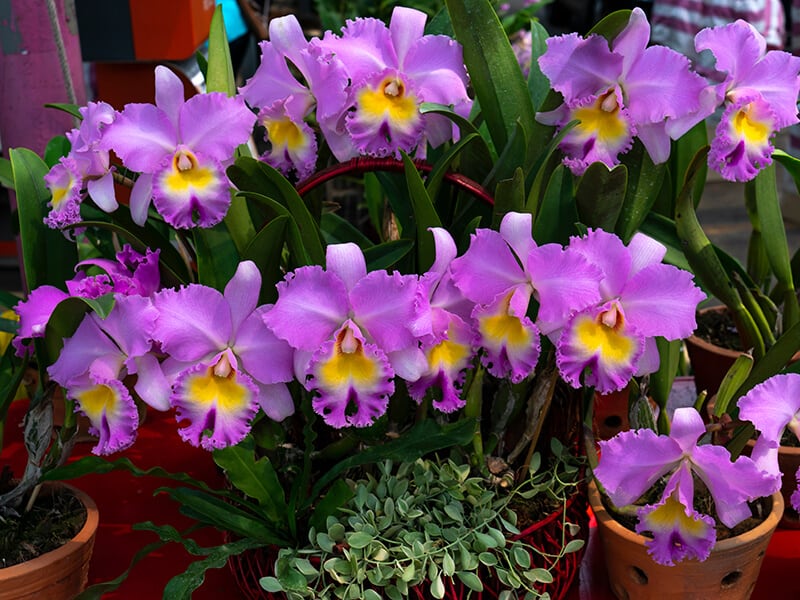
Cattleya Orchids develop beautiful snowy and fragrant flowers in different colors. My favorite is purple Cattleya Orchids because they have large blooms. Unfortunately, the plant only blooms once a year, but you may find a hybrid that will produce several flowers per year.
Here is what you need to know about Cattleya Orchids before you start growing them in your home!
#35 Coneflower
Purple Coneflower or botanically Echinacea purpurea is grown for its ornamental value but also for practical purposes. The plant attracts pollinators in the flower bed, so it ensures that something also pollinated nearby plants. It develops beautiful tall flowers, similar to Daisies.
Find out when purple Coneflowers become invasive!
#36 Candytuft
Iberis or Candytuft is a common border plant. It is one of the charming, late bloomers.
The plant develops either white or pinkish, purple flowers in masses. They stand out against vivid green foliage. People also plant Candytuft in moon gardens!
Is Candytuft a perennial plant? Find out now!
#37 Common Comfrey
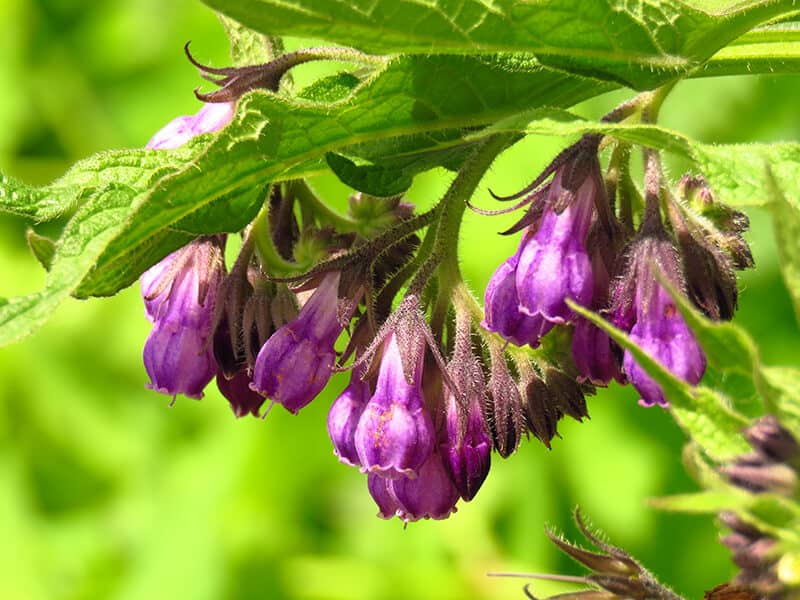
Symphytum officinale of Comfrey is grown for its beautiful appearance, but also for healing properties. It is believed that Comfrey helps with skin wounds and inflammation. In the past, people also used it to aid broken bones.
Find out how to grow Comfrey in your garden!
#38 Garden Cosmos
Cosmos bipinnatus or Cosmos plant is one of the easiest purple plants to grow. All you have to do is sprinkle the seeds in the garden after the frost has passed and wait for the plant to mature.
The germination is somewhat slow, but the flowers will appear soon and last for months!
Find out all the benefits of growing Cosmos in your garden!
#39 Melastoma
Melastoma Candidum is an invasive shrub, grown for landscaping and medicinal purposes. The plant develops edible fruits with sweet flavors and yellow seeds.
However, be careful when planting Melastoma, it can be very invasive and attract the nearby vegetation.
Read the primary information on Melastoma!
#40 Camas Lily
Camas Lily has exotic, purple-blue flowers which develop in the spring. It is easy to grow and responds well to droughts and different weather conditions. Other common names for the plants are Wild Hyacinth and Indian Lily.
Learn the history of the Camas Lily plant!
#41 Blue False Indigo
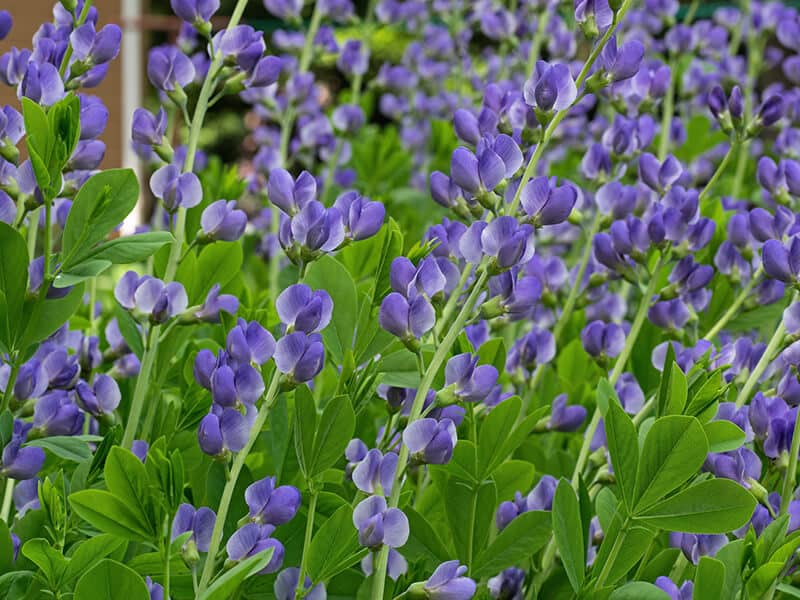
Baptisia australis or Blue False Indigo needs one year to reach its maximum height if you plant it from seeds. Give it another three or four years for the flowers to appear and enjoy a colorful display of stunning bluish, purple flowers. The plant is resistant to pests and diseases and has a long-season interest.
Follow the process of growing Blue False Indigo from seeds!
#42 Lily of the Incas
Alstroemeria, commonly known as the Lily of the Incas or the Peruvian Lily, is native to South America. This perennial plant develops clusters of flowers in different colors, including purple.
The plant is hardy, easy to grow, and often seen on the borders of the garden!
Read more tips for growing Peruvian Lily!
#43 Hyacinth
Hyacinthus orientalis feature strap-shaped foliage and purple, upright flowering clusters, similar to florets. The plant is low-maintenance and thrives in sandy and loamy soil. You can grow it in flowering beds, in containers, or near the borders of the garden.
Here is what to know about simple Hyacinth care.
#44 Columbine
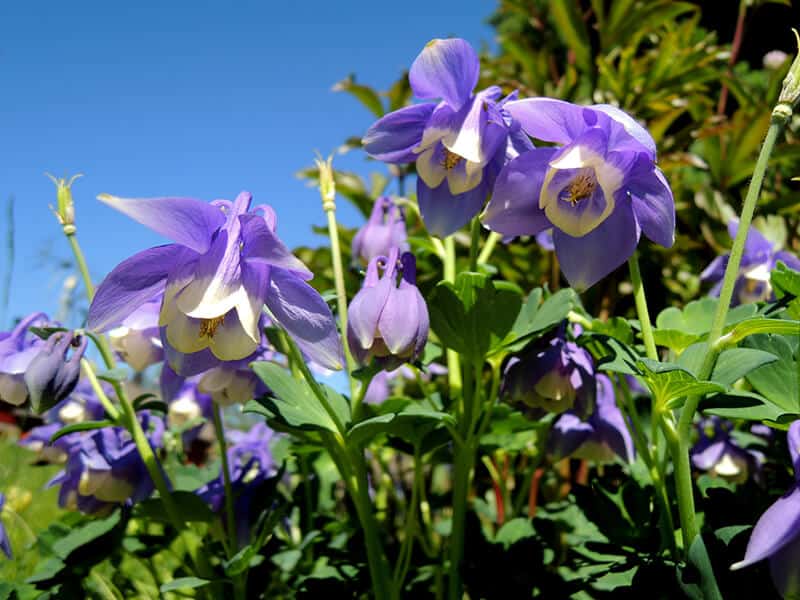
Granny’s Bonnet, Columbine, or Aquilegia is a wonderful perennial plant. The plant features delicate, lacy foliage and bell-shaped flowers. It blooms in the middle of the spring and the flowering season lasts until the end of the summer. There are many varieties, including the dwarf ones that are great for ground covering.
Read more about the Columbine plant!
#45 Cheeses
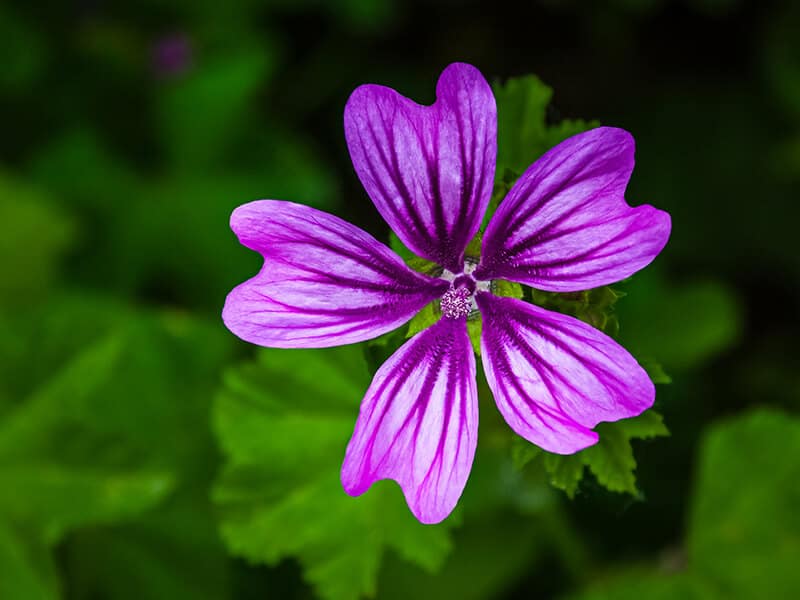
Malva Sylvestris or Cheese plant has tall stems and funnel-shaped blooms. Because of its striking appearance, the plant is used as the focal point in landscaping.
Also, Malva has a long blooming season – from spring till autumn!
Check the important information on the Malva plant!
Indoor Plants with Purple Flowers
Here is a careful selection of the plants with purple flowers better suited for indoor use. Check the list and don’t forget to pick your favorites!
#46 Cape Primrose
Streptocarpus or Cape Primrose is a popular houseplant. It is one of the rare plants that doesn’t mind low-light conditions! However, the intensity of the flowers depends on the light. Therefore, some plants may bloom up to ten months per year!
Read more about Cape Primrose care!
#47 Phalaenopsis Orchid
Phalaenopsis Orchid can be tricky to grow. However, if you apply orchid-intended fertilizer and report regularly, you might not have any issue with your Orchid.
This species is sometimes called Moth Orchid, and it is a popular household Orchid variety.
Learn when the ideal time for repotting Phalaenopsis Orchid is!
#48 False Shamrock
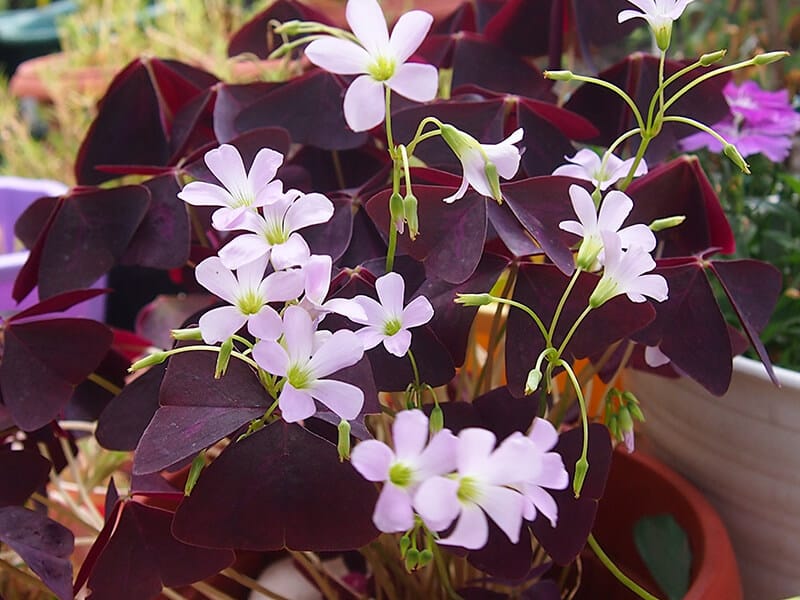
Oxalis triangularis or False Shamrock is a lovely plant with deep purple foliage and pastel purple, star-shaped flowers. It pairs well with green plants and has ornamental value even outside the blooming season.
Read more about this intriguing plant!
This is how to start False Shamrock from scratch:
#49 Christmas Cactus
Christmas Cactus or Schlumbergera can be tricky to get to bloom. But, the flowers are in vivid shades of red, pink, and purple and worth all your effort!
Other names for the plant are Thanksgiving cactus or a Crab cactus.
Find out how to make your Christmas cactus bloom!
#50 Cyclamen
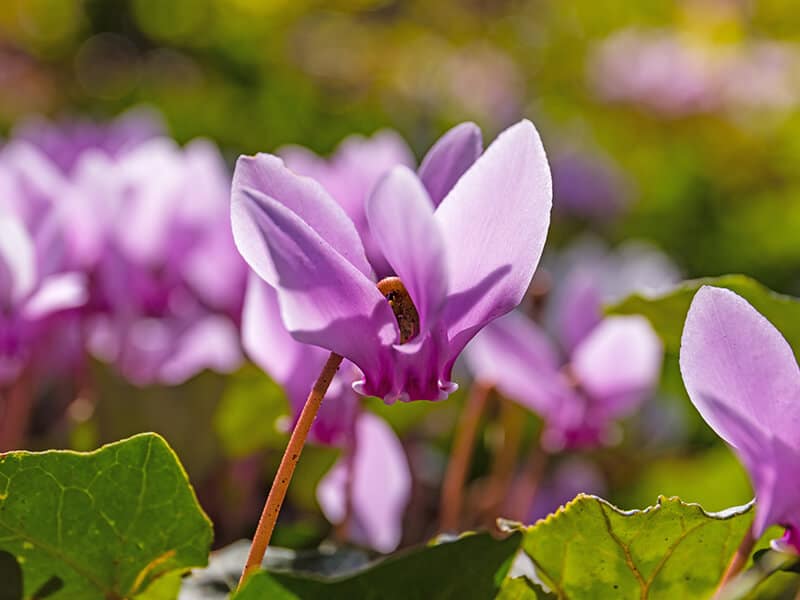
Cyclamen are easy to grow indoors, but you have to ensure cool temperatures. Therefore, you may put them in the chilly hallway or even on the balcony. If your Cyclamens are exposed to too much light, the plant will go dormant.
Once you bring it back to chillier temperatures, it will produce beautiful flowers once again!
Here is how to take care of Cyclamens!
#51 Bougainvillea Bonsai Tree
Bougainvillea is an outdoor plant with a great impact. If you want to enjoy the beauty of its vivid purple, pinkish flowers indoors, you may choose the Bougainvillea Bonsai Tree! It will thrive if you provide the ideal growing conditions.
Do you want to know how to bonsai Bougainvillea by yourself? Click here to find out!
Learn how to repot Bougainvillea Bonsai plant:
#52 Fuchsia
All varieties of Fuchsia are suitable for indoor use if you learn how to take care of the plant. It develops bright red flowers with purple centers. The flowers have a unique shape, and their beauty depends on the proper watering routine.
Most Fuchsia plants enjoy self-watering containers.
Look at more practical tips on growing Fuchsia indoors!
Find out what is the best way to prune your Fuchsia with this video:
#53 Blazing Stars
Liatris spicata or Blazing Stars can be grown indoors and outdoors. But, you’ll need to ensure that the plant receives enough sunlight indoors.
The plants develop lovely flowers in white, pink, and purple!
Learn more about Liatris varieties!
#54 Heliotrope
Heliotropium or Heliotrope is famous for its fragrant flowers in all shades of purple! The plant also develops dark, green, and rich foliage which increases the seasonal interest in the plant. Even though it is more often grown as an outdoor plant, you can successfully grow it indoors.
Here is what you need to know about growing Heliotrope indoors.
#55 Aechmea Blue Rain Bromeliad
Aechmea, more specifically the Blue Rain Bromeliad variety, is a low-maintenance indoor plant. All you have to do is water the plant once a week and mist the foliage occasionally. Blue Rain Bromeliad looks out of this world – with bright red stems and purple clusters of tiny flowers!
Read more about this exotic houseplant!
#56 Crocus
When growing Crocus indoors, it is essential to ensure excellent drainage. Otherwise, the plant will slowly rot and die.
When given enough sunlight, Crocus becomes the statement piece in your plant collection. The stunning lavender-purple flowers are the most beautiful part of the plant!
Carefully go through a beginner’s guide for growing Crocus and decide whether the plant is for you!
#57 Pink Quill
Wallisia cyanea or Pink Quill has got the name from purple plum and vivid pink bracts. The plant has narrow foliage and blooms during the summer. In the summer, the violet-blue flowers appear around the bracts and make the plant attractive and unique.
Is Pink Quill difficult to grow? Find out here!
#58 Foxglove
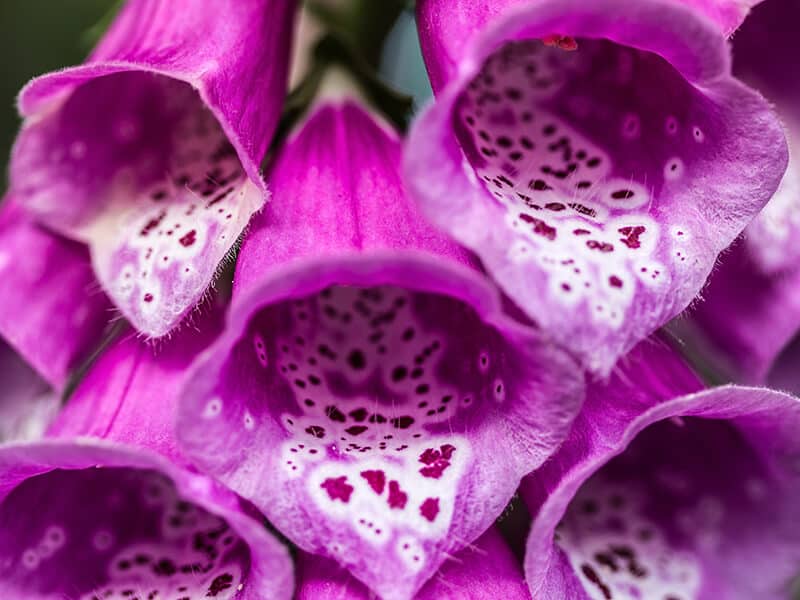
Digitalis or Foxglove grows indoors and outdoors. But, you’ll have to ensure the plant has enough sunlight to survive indoors!
The ideal conditions are cooler temperatures, rich soil, and partial shade. Foxglove develops masses of small, bell-shaped flowers and adds a burst of color in every indoor setting.
Find out if Foxglove is poisonous.
#59 Dendrobium Orchid
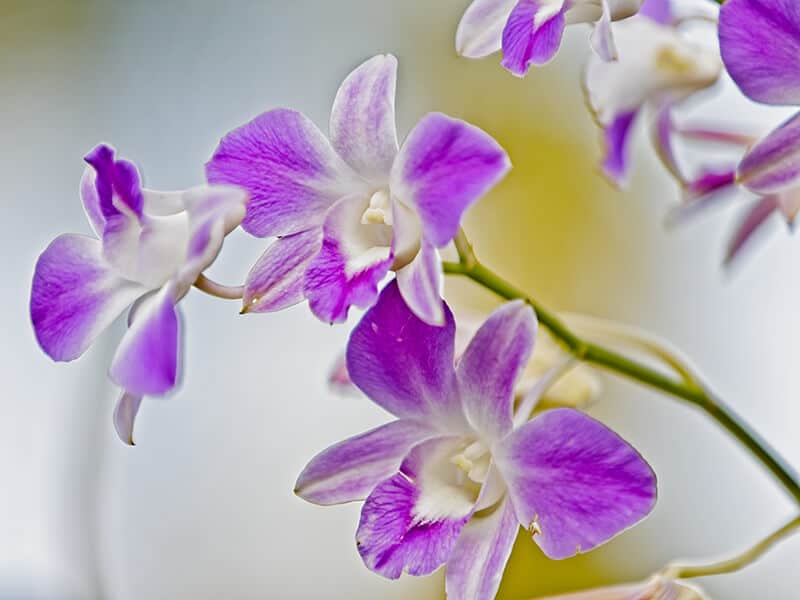
Dendrobium Orchid develops clusters of flowers and even in different color combinations. The blooms are spectacular, but it may be challenging to care for Dendrobium Orchid. It enjoys air circulation and cooler temperatures.
Find out what the ideal growing conditions for Dendrobium Orchid are.
#60 Purple Vanda Orchid
Vanda Orchid is an exotic plant with large and luscious purple flowers. It is more resistant than other Orchid species. The key to keeping your Vanda orchid healthy is regular misting, as the plant loves high humidity and tropical-like conditions.
Here is more information on Vanda Orchid!
#61 Suffolk Lungwort
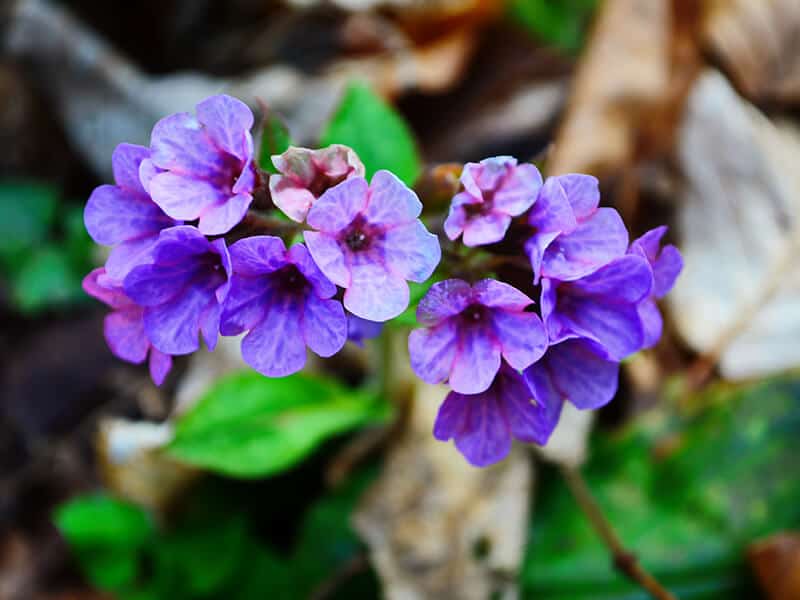
Lungwort is primarily grown outdoors, but you can manage to keep it healthy and in your home as well. The scientific name is Pulmonaria Obscura, and the plant needs a balance between humidity, sunlight and moisture.
If you manage to keep the plant healthy, it will award you with lovely flowers, purple and pink, in the early spring.
Do you want to know the secret to growing Lungwort indoors? Click here to find out!
#62 Hollyhock
Hollyhocks are tricky to grow in pots because they need a lot of space because of their long taproots. Ideally, pick barrel-shaped pots, and choose an indoor location that receives at least six hours of sunlight per day. During summer, you may place your Hollyhocks outside!
The botanical name of this plant is Alcea.
Read more about proper Hollyhock care!
#63 Pelargonium
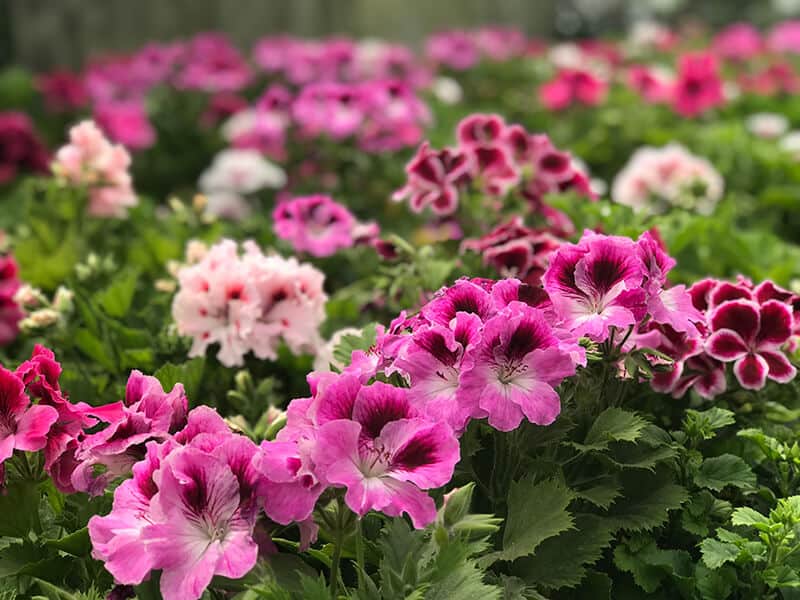
Pelargonium is a reliable indoor plant. It is famous for its long-lasting blooming season. You’ll have to provide enough sunlight to the plant, and it will award you with stunning flowers year-round! You may also grow vining hybrids for better effect.
Read more about growing Pelargonium indoors.
The best technique to cut back Pelargonium. Watch this video:
Is There a Perfect Purple Flower?
Choosing purple flowers for your garden and home is challenging because there are so many beautiful purples! My top pick for garden and low-growing plants and viners, such as purple Sweet Pea.
But, I also cannot resist the royal Dendrobium Orchid, it looks luxurious and instantly brightens all rooms!
What is your top pick? Do you like purple flowers? Please share your preferences!
Come back for more plant growing tips and gardening inspiration!
